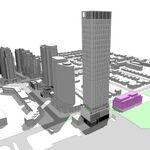In your Letter of Application to CTA of 29 Jun 16 you claim that MOOSE will operate a 400km (
para 20) network over 3 lines (
Annex F). There will be approximately 50 stations (
para 20). You indicate that you will use 6 trains to do that. (
Annex J, para 3b) and that you will provide hourly service (
page 6 of update 25 Nov 16).
To do that you would need each train to complete its run from end to end of each line in under an hour, give some time to conduct your “pit stop program” at the end of each line (
Annex J, para 4.2), and then head out again in the opposite direction.
This is obviously impossible. Some simple math:
Good math aside, I couldn't find where it says that "6 trainsets" and "50 stations" are the /startup/ phase.
The exact paragraph says:
(b) Start-up service assessments will assume use of two Bombardier BiLevel Coaches and one Cab Cars per trainset, with six running trains, plus two spare coaches and two spare Cab Cars. No train supplier has yet been selected, and this train, built in Thunder Bay, Ontario, is a convenient and realistic planning reference.
I tried to hunt the PDF file to figure out whether start-up service will be 50 stations at the beginning, but I could not find it. At this moment, I consider your post void until this is clarified.
Read again. "START UP SERVICE" -- a tidbit Charles conveniently left out.
I wonder if Joseph Potvin also expects that OC Transpo would establish a condominium corporation around each of their own stations, gather revenue through that corporation, and then subsequently pay MOOSE a stopping fee to have their own trains stop at their own stations.
Joseph Potvin would have to make good with OCTranspo, then everything's the limit.
In Toronto, Metrolinx is increasingly working with real estate now. The new bus terminal is one example (bus station integrated as part of condo), and the Mobility Hub concept where they are currently open to negotiating agreements with developer to convert a parking lot into a mixed-use complex (with integrated parking in compensation).
I agree that stations should not be suburban single-detached dwellings, as that is mathematically too low-density to give good ROI for a MOOSE station. Real estate developers, would plan medium-densities minimum, and probably a few low-rise towers, to justify the cost of a MOOSE station. The small-town bedroom-community type stuff, but at least it's better than a suburb and has the potential to grow employments in those areas too (e.g. offices, etc).
Now, I don't advocate building density in GATINEAU Park, but Bayview does have density potential (especially if the ugly soviet "Ottawa City Centre" is demolished) and there are also stops in Hull, too, and at least one other densifyable stops. Wakefield already has a train station (albiet a bit of renovation needed) so most of the cost is reactivating the train line (rail maintenance/refurbishment, etc) and would be a lower-cost MOOSE line to startup with, with a few "Densifiable" stations and a few "legacy" stations. Opportunistically, I guess a couple of stations could be simpy GO-style parking lot suburban stations, but that's just basic stops in the line.
This is actually an excellent point I hadn't considered. The uplift is proportional to usage. If there is little to limited usage...read feeder traffic to businesses along the line, values will tank.
The last few posts on SSP Ottawa have been so enlightening. This really is starting to look less like a naive but innocent attempt at improving transit. And more like an attempt at scamming rural investors.
The good thing, the longer this and the SSP thread, the more that Mr. Potvin will be on record for any and all to see.
It's a good thing to discuss this open, pick apart, tear down the planning. There are a huge number of flaws (And maybe the MOOSE plan is unsustainable) but I daresay the number of flaws are currently being exaggerated by Charles.
Look closer, and let us rip apart the trye legitimate arguments. The "six train" bleep by Charles isn't the right thing to attack, because that is only the
startup phase, according to my reading of the PDF. Let's find the actual flaws, please.
There are statements made by Mr. Potvin I am indeed very concerned about (e.g. I'd like to see breakeven revenue scenarios, of multiple different what-if scenarios for how many passengers, including best-case and worst-case scenarios, and what the contingency plans are).
I certainly wouldn't want to remove any Trillium stations along the route, and I certainly wouldn't want suburban sprawl (rather than proper density pockets along a corridor) so the MOOSE plan needs to be modified somewhat to accomodate certain realities, but there's also a baby in the bathwater too -- we're arguing what the baby is and what the bathwater is.
If I was a Chinese investor of the MOOSE plan, I'd certainly want to see a Business Plan that actually plugs in approximate real-estate densities & values, ridership simulations, and outputs a "average cost per passenger" data (of multiple theoretical scenarios, good-economy and bad-economy), say, including 5-station, 10-station and 50-station scenarios. The sort of data I'd love to see.
Certainly one might be asked to sign an NDA "to see the numbers" better. However, to also increase public trust in the plan, certain information may need to be released strategically if there is truly a good public benefit, especially if to bring parties like Ottawa/VIA/OCTranspo or whomever onboard (VIA's considering commuter trains in Halifax!). There's possibly multiple dark-horse parties that MOOSE might ultimately team up with (And maybe also change the business plan somewhat) to make things much more feasible, in theory.
Currently, on a technological basis, my biggest question of concern will be how to reconcile the Trillium line with MOOSE, which could actually raise costs dramatically, but I do see theoretical startup phases that doesn't require interlining with Trillium (until later "problem-solved", e.g. when MOOSE electrifies as a theoretical future-phase) -- basically stubs like a Wakefield-Chelsea-Hull-Bayview train service as part of the startup calculus. And none of the station-removal stuff for Trillium. Technically, the MOOSE spurs can operate independently (and deadhead at night to maintenance yard), leaving the Trillium section out initially (e.g. Bayview station area becomes the interchange terminus for the Wakefield MOOSE spur).
Anyhow:
I'll be the open-minded glass half-full "skeptic" here. But I believe (on a re-reading of the PDF, the
startup '6 train' is clearly disassociated with
full-buildout "50 station" stuff.), it clearly looks like that Charles is hitting below the belt with eye-roll cherrypicked stuff in negativity-amplification manoevers (in between legitimate questions/concerns). Puh-lease.




